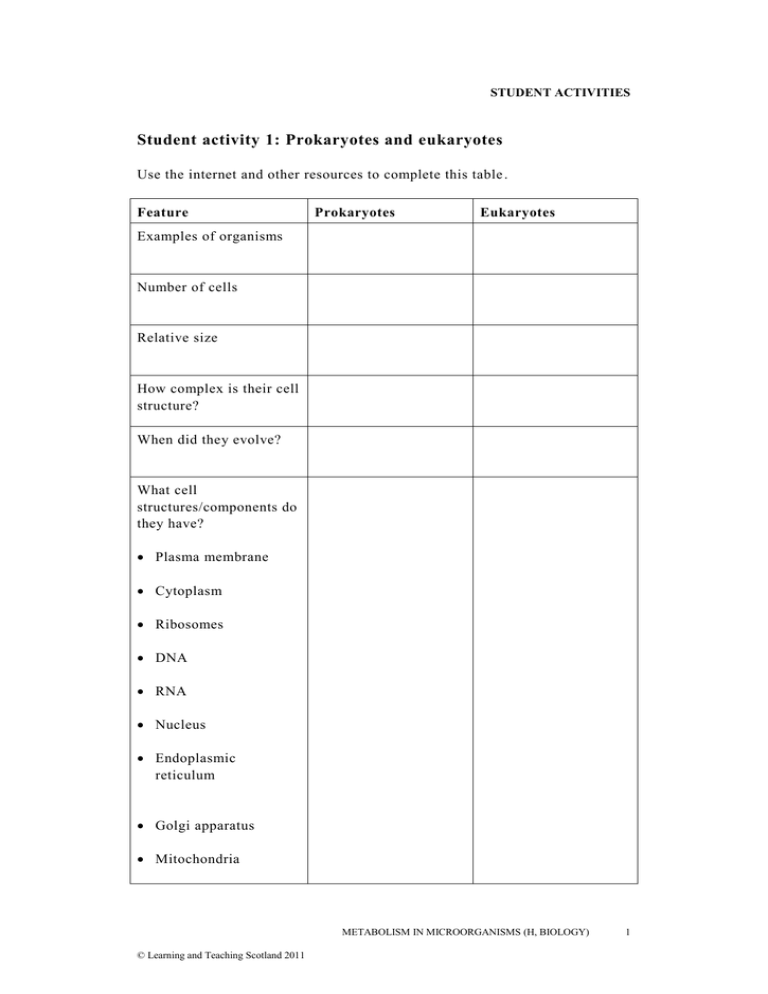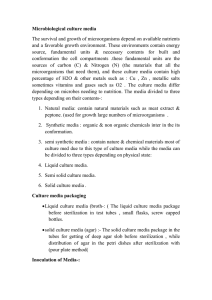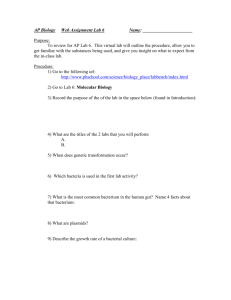Student activity 1: Prokaryotes and eukaryotes
advertisement

STUDENT ACTIVITIES Student activity 1: Prokaryotes and eukaryotes Use the internet and other resources to complete this table . Feature Prokaryotes Eukaryotes Examples of organisms Number of cells Relative size How complex is their cell structure? When did they evolve? What cell structures/components do they have? Plasma membrane Cytoplasm Ribosomes DNA RNA Nucleus Endoplasmic reticulum Golgi apparatus Mitochondria METABOLISM IN MICROORGANISMS (H, BIOLOGY) © Learning and Teaching Scotland 2011 1 STUDENT ACTIVITIES Chloroplasts Lysosomes Diagram (draw or cut and stick here or attach separately) Any other information 2 METABOLISM IN MICROORGANISMS (H, BIOLOGY) © Learning and Teaching Scotland 2011 STUDENT ACTIVITIES Student activity 2: Culturing microbes Use the internet and other resources to find out about the following topics. These relate to the work you have just completed on how to culture microbes. What are spores and how do they affect the food industry? Describe the flash pasteurisation method of preventing contamination. Find diagrams and information about the filter sterilisation methods: membrane filters and HEPA. How do the paper, textile and nuclear industries prevent growth of microbes in their products? What do the antiseptics silver nitrate, iodine solution and hydrogen peroxide do? What use do the disinfectants copper sulphate and iodine solution have? METABOLISM IN MICROORGANISMS (H, BIOLOGY) © Learning and Teaching Scotland 2011 3 STUDENT ACTIVITIES Student activity 3: How temperature affects the growth of microbes Use various classroom resources to complete the following table. It relates to the three groups of microbes that thrive in different temperature conditions. Microbe group Temperature conditions and habitats Psychrophiles Mesophiles Thermophiles 4 METABOLISM IN MICROORGANISMS (H, BIOLOGY) © Learning and Teaching Scotland 2011 Examples of microbes that live here How they cope with living in these conditions, eg adaptations they may have Any other information STUDENT ACTIVITIES Student activity 4: The effect of temperature on microbial growth. Equipment (this may vary depending on how you choose to set the activity up, eg one group may do one temperature etc) Four agar plates Slope cultures of Bacillus subtilis and Micrococcus Luteus, Bunsen burner and heatproof mat Alcohol in a beaker (to flame wire loop) Wire loop Fine marker pen for agar plates Sellotape Antibacterial wipes, gloves, goggles and other equipment required to ensure aseptic technique CAUTION: Do not have the beaker of alcohol near a naked flame – can cause fire. Method 1. Clean the laboratory bench prior to commencing this practical to ensure clean working conditions. 2. Wash hands and put on gloves. 3. Draw a dividing line on the underside of each agar plate . 4. Label each side of the plate with a different bacteria name , eg B. subtilis or M. luteus. 5. Use the wire loop to inoculate one half of the plate with M. luteus. Do this by plating a single line of the microbe over the surface of the plate half. Take care to ensure that the agar plate is not left exposed to airborne bacteria by keeping the lid on for as long as possible. 6. Sterilise the wire loop by placing it in the flame, cooling it and placing it in alcohol before re-flaming it. 7. Repeat the inoculation with B. subtilis on the other half of the plate once the wire loop has cooled. 8. Tape down both sides of the plate and put your initials on it. METABOLISM IN MICROORGANISMS (H, BIOLOGY) © Learning and Teaching Scotland 2011 5 STUDENT ACTIVITIES 9. Place the plate in the required temperature conditions: 10 , 20, 37 or 50°C. 10. Repeat steps 5–9 if you are doing every temperature. If this is the case, it would be easier to inoculate all four plates with one bacteria then repeat with the other. 11. After 24–48 hours remove the plate and look for signs of bacterial growth. Devise a class key to determine what counts as absence , scarce, moderate or abundant growth by observation of the plates. For example: absence = no bacteria growing scarce growth = bacteria growing on 10% of the plate moderate growth = bacteria growing on 35% of the plate abundant growth = bacteria growing on 50% + of the plate 12. Comment on the temperatures where the microbes grow best. 6 METABOLISM IN MICROORGANISMS (H, BIOLOGY) © Learning and Teaching Scotland 2011



